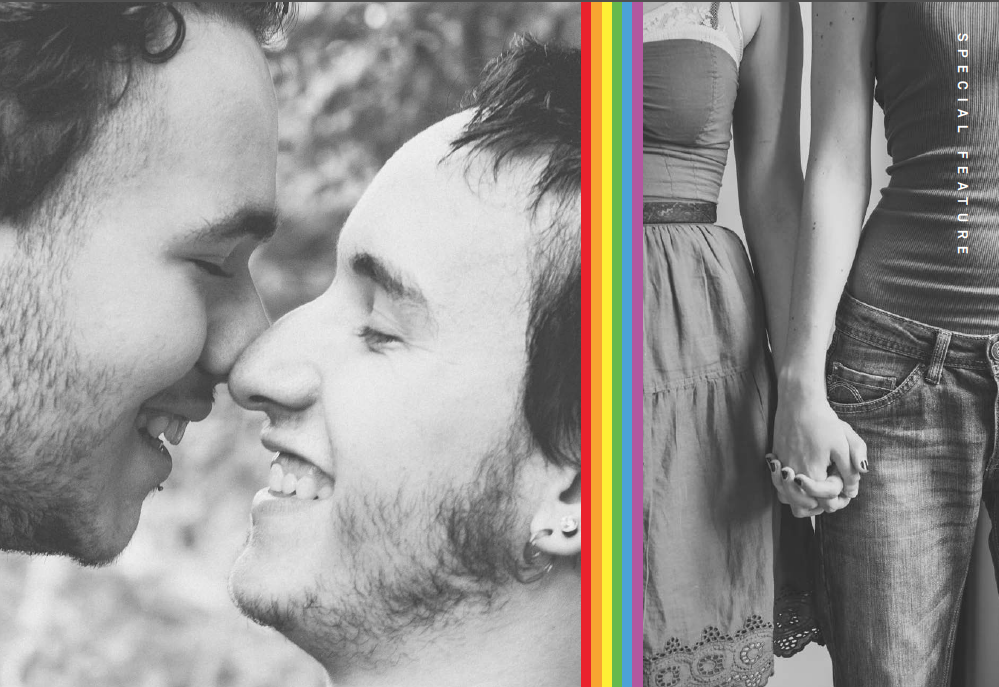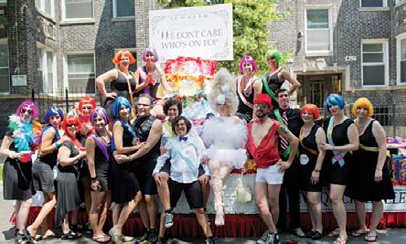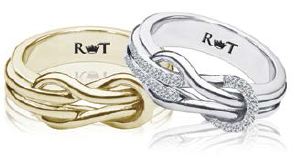
equaltime
Expert advice for serving
same-sex couples
in the age
of marriage equality
With June’s supreme court decision in Obergefell
v. Hodges, the 14 states that didn’t permit same-sex marriage
joined the 36 that already did. As quickly as front pages
and Facebook feeds registered the news, jewelry businesses
began to speculate how another wave of wedding-eligible
couples might influence their businesses. Publicly traded
jewelry companies like Signet Jewelers and Tiffany & Co.
— the latter unveiled its first-ever ad campaign featuring a
same-sex couple earlier in the year — saw small jumps in
their share prices on the day of the marriage equality ruling.
Meanwhile, some independent retailers are making it their
business to win over same-sex couples.


LGBT consumers
are
an estimated
6 percent of
the population.
Advertisement
According
to a 2015
Gallup poll
60 percent
of Americans
support
same-sex
marriage.


Long’s Jewelers, a family-owned business
with five locations throughout Massachusetts,
was quick to show its enthusiasm
for the court’s ruling. With only hours to
spare between the marriage equality decision
and the deadline to place an ad in the
Sunday edition of The Boston Globe, New
England’s largest newspaper, the Long’s
team “brainstormed a few ideas and put
something together really quickly,” said
Long’s president, Craig Rottenberg. The
result, an image of a watch with a bezel in
rainbow colored gemstones beneath the
caption “It’s About Time” and the date
of the June 26, 2015 marriage equality decision, was “one of our most impactful
ads ever” and received “zero negative
comments” Rottenberg says. “A number
of calls have come in to buy the watch,”
which was a digitally altered stock photo,
“but it’s not something we sell. We ran the
ad without commercial considerations.”
The ad was the latest example of the
store’s record of inclusive outreach. In
2013, Long’s featured same-sex couples
in a campaign that ran in local LGBT
magazine Boston Spirit.
In the current climate it’s not surprising
Long’s ad made a big impact. LGBT
consumers are an estimated 6 percent of
the population, but they’re not the only
customers who pay attention to a store’s
open and accepting attitude. According to
Ian Johnson, CEO of Out Now, an agency
specializing in LGBT marketing, “‘allies’
— people who are supportive of LGBT
people they know personally as friends,
family members or work colleagues —
account for more than 50 percent of the
total consumer market” in most countries
where it conducts research, including the
United States. And according to a 2015 Gallup
poll 60 percent of Americans support
same-sex marriage. “Most businesses have
more to gain than lose by being known as
a business that actively supports LGBT
people as customers,” Johnson says.
In 2010, Mervis Diamond Importers,
a jeweler with locations in and around
Washington, DC, cemented its status as a
retailer that would welcome LGBT clients
when it introduced its own line of jewelry
for same-sex couples months before they could legally marry in the area, complete
with a “coming out party” to launch the
collection. The Mervis stores have reaped
benefits from being an early supporter of
same-sex couples ever since. “We still get
referral after referral from couples that
we worked with before the laws changed,”
says chief growth officer Jonathan Mervis.
Advertisement
To cultivate an environment that’s
welcoming to everyone, the stores avoid
anything “specifically defined as heterosexual,”
Mervis explains. “Until a client
pointed it out, we didn’t realize we used
a form that read ‘her ring’ and ‘his ring,’
‘her finger size’ and ‘his finger size.’ Now
the form says ‘guest 1’ and ‘guest 2.’”
Steve Quick describes his three Chicago-
area Steve Quick Jeweler boutiques as
“just like any jewelry store.” Unlike most
jewelry stores, however, Steve Quick Jeweler
closes on the day of the Chicago Pride
Parade and the staff travels the parade
route on its own float, each year flaunting a
different theme, like “Love is Love.” Quick
is no stranger to supporting same-sex
couples. In the 1990s, he ran several ads
that read, “We believe in the right of all
loving couples to be married,” a position
that was significantly less common then
than it is today. “You can’t please everybody,”
is Quick’s response to the notion
that he may have lost customers by being
outspoken in support of LGBT clients.
He’s just as matter-of-fact when describing
how he and his staff approach
same-sex couples. “We don’t do anything
specific. We’re careful and respectful. We
have a great selection and just do what
we normally do; [same-sex couples] will
probably find what they’re looking for.”
Data suggests that same-sex couples
may be looking for more rings than straight couples and spend accordingly. A survey
conducted by the Gay Wedding Institute
and Community Marketing Inc. indicated
that 19 percent of same-sex male couples
and 66 percent of same-sex female couples
purchased engagement rings. Unlike the
accepted formula among straight couples
of an engagement ring and wedding band
for the bride and a single wedding band
for the groom, same-sex couples aren’t
bound by long-established wedding roles
and traditions.
“There’s no guidebook that answers
the question of who proposes to whom or
who will wear a diamond ring,” says Rony
Tennenbaum, a jewelry designer who
markets his 7-year-old namesake brand
to gay and lesbian couples; distribution of
the collection has jumped from 12 to 32
stores since last year. Beyond designing
jewelry, Tennenbaum frequently makes
appearances to help LGBT clients navigate
the possibilities of same-sex engagement
and wedding rites, a theme he calls “The
New Etiquette of the Rainbow.” Often
asked whether a same-sex couple should
get matching rings, for example, Tennenbaum
advises “maintaining individuality
within couplehood. There’s no reason one
partner can’t wear a big diamond and the
other a simple band if that’s what each
one wants.” Likewise, he believes couples
needn’t stick to traditional designs. His
“Tie the Knot” style, a nautical-inspired
ring that doesn’t resemble typical wedding
jewelry, is one of his top sellers. “Many
different rituals and protocols will evolve
along with the concept of the modern
family,” Tennenbaum says.

Advertisement
Major jewelry brands are paying attention
to same-sex couples, too. Frederick
Goldman, whose portfolio of brands includes wedding jewelry mainstays Art-
Carved and Triton, offers its “customers
and partners specific marketing materials
tailored specifically to the LGBT community,”
says chief marketing officer Robin
Scheer Ettinger.
Ronnie Adolf of Adolf Jewelers in
Richmond, VA, sells jewelry from Rony
Tennenbaum and Frederick Goldman
and uses resources from both to reach
same-sex couples. He tells retailers never
to jump to any conclusions.
“When someone walks into
your store, you never know
whether that person is from
a same-sex couple or not.
Two men who are shopping
together might be a couple
or they might be best friends.
Our job is to listen and learn.”
To communicate with samesex
couples in areas where
LGBT communities may be
smaller and less visible than
they are in the largest urban
centers, it can be beneficial to connect
with a local LGBT organization, like an
affiliate of the National Gay and Lesbian
Chamber of Commerce. “If you’re not
a part of the community, it helps to get
some guidance,” Adolf says.
Jewelers Equality Alliance (JEA) is an
organization whose mission is to help the
jewelry industry become fully inclusive of
same-sex couples. According to alliance
president Matthew Perosi-Doughty, longheld
retail practices focus on traditional
couples. “If a guy walks into a jewelry
store looking for an engagement ring,
he’s usually asked about his girlfriend,” he says. “That means a gay man has to
start the conversation by correcting the
salesperson’s assumptions and feeling
unsure of what the reaction will be.”
It’s the kind of misstep JEA wants to
help jewelers avoid with a combination
of training programs and educational
materials meant to help jewelry professionals
better serve same-sex couples. The
organization, which launched in July, is
creating webinars and newsletters to touch
on news and trends relevant
to the LGBT community and
will be available to stores that
pay annual JEA dues.
JEA has begun compiling
a library of imagery featuring
real same-sex couples
for use in stores’ marketing
and advertising, and will help
businesses create mediabuying
strategies in LGBT
or mainstream outlets. Perosi-
Doughty recommends stores
use imagery that broadens the
focus beyond straight couples. “Featuring
images of a bride alone or a best man
pinning a boutonnière to a groom’s lapel
won’t alienate anyone, including a store’s
traditional clientele,” he says. “And when
a store’s materials feel open and accepting,
gays and lesbians don’t have to guess
whether they’ll be welcome.”
That guessing game is one reason that
same-sex couples shop for jewelry online
in higher rates than straight couples. It’s an
environment with less customer service,
but also without the potential for being
judged. Making the rest of the jewelry
world an inclusive place will be a “gradual
process,” Perosi-Doughty says, “but 20
years from now I hope the conversation
will be totally unnecessary.”
For stores that want
to make same-sex
couples feel welcome,
there are a few dos and
don’ts that can make
all the difference
DO: RETHINK “BRIDAL” Retailers commonly use the word
“bridal” as a general term for weddingrelated
jewelry, but it excludes couples
that don’t include a bride at all. “Men
don’t relate to the word. It’s better to
describe the category as ‘wedding and
engagement jewelry,” says Perosi-
Doughty of the Jewelers Equality
Alliance.
DON’T: MAKE ASSUMPTIONS
“LGBT customers often feel apprehensive
about retail transactions,
knowing that they may have to ‘out’
themselves to the salesperson” explains
Ian Johnson, CEO of Out Now.
Starting a discussion with a question
like, ‘Is this item for you or your partner?’
reassures them that you’re open
to the possibility that they might be in
a same-sex relationship.”
DO: CONSIDER
A TRAINING SESSION Most retailers want to be able to help
all their clients effectively but “feel
poorly informed about the specific
concerns of LGBT customers,” explains
Ian Johnson of Out Now. “Offering
staff training that debunks stereotypes
and addresses how to react to
the unexpected gives them practical
tools to provide successful customer
service.”
DON’T: GO OVERBOARD
WITH RAINBOWS
AND TRIANGLES
Rainbow flags and pink triangles signify
LGBT pride, but that doesn’t necessarily
mean same-sex couples want
wedding jewelry that features the
symbols. “Like anyone else, gay people
want to wear something intimate and
personal as a symbol of their love,”
says Rony Tennenbaum.
DO: USE THE RIGHT MEDIUM
FOR YOUR MESSAGE There are many different kinds of media,
associations and not-for-profit organizations
that can be resources for
reaching the LGBT community, each
with different points of view. “Find a
partner that communicates with the
community in a way that’s comfortable
for you and consistent with how
you want to run your business,” says
Craig Rottenberg of Long’s Jewelers.